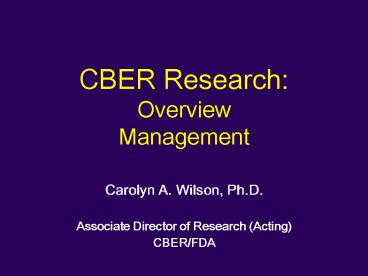CBER Research: Overview Management - PowerPoint PPT Presentation
1 / 20
Title:
CBER Research: Overview Management
Description:
... 2 Improve clinical trial design and evaluation, including adaptive design approaches Develop formal risk management and risk assessment approaches Enhance ... – PowerPoint PPT presentation
Number of Views:136
Avg rating:3.0/5.0
Title: CBER Research: Overview Management
1
CBER ResearchOverviewManagement
- Carolyn A. Wilson, Ph.D.
- Associate Director of Research (Acting)
- CBER/FDA
2
CBERs Mission
- To ensure the safety, purity, potency, and
effectiveness of biological products, including
vaccines, blood and blood products, and cells,
tissues and gene therapies for the prevention,
diagnosis, and treatment of human diseases,
conditions or injury.
3
Vision for CBER
- Protect and improve public and individual health
in the US and, where feasible, globally - Facilitate development, approval and access to
safe and effective products and promising new
technologies - Strengthen CBER as a preeminent
- regulatory organization for biologics
INNOVATIVE TECHNOLOGY ADVANCING PUBLIC HEALTH
4
Critical Products for Public Health, National
Preparedness 21st Century Medicine
Blood Derivatives
Vaccines
30 million
235 million
Blood Components
Allergenics
Whole Blood
Somatic Cell Gene Therapy
Devices
Devices
Tissues
Xenotransplantation
1 million
5
CBERs Approach to Regulation
FDC and PHS Acts Combined with Regulations
Rational Policy and Decisions
6
Multitasking at the FDA Research Supports
Regulatory Mission
- CBER researchers fully integrated into the
regulatory process (50 average time)
Researcher-Regulator - Review INDs, BLAs, 510ks, PMAs, IDEs, HDEs
- Development of Policy and Guidance Documents
- Meeting with Sponsors and Advisory Committees
- Participation in Pre-license and Biennial
Inspections - Evaluation of Adverse Drug Reactions and Risk
Assessment - Performing research relevant to product
evaluation of safety, efficacy, manufacturing
Developing/evaluating scientific tools
knowledge - Outreach, communication with stakeholders
7
CBER Research Solutions
- Prepare for long-term programmatic needs AND for
crisis responsiveness - Outcomes driven Identifying and resolving
specific, high priority scientific challenges in
product evaluation - Focus on critical gaps in scientific tools and
knowledge for product evaluation - Support product development for critical, unmet
public health needs - Where feasible, multidisciplinary, coordinated
team research for regulatory challenges - Internal and External Communication
8
CBER RESEARCH MANAGEMENT OVERVIEW
2. CBER RESEARCH PRIORITIES
EXTERNAL REVIEW AND INPUT
- IDENTIFICATION
- OF
- REGULATORY
- AND
- PUBLIC
- HEALTH NEEDS
3. OFFICE RESEARCH PLANS AND PRIORITIES
4. RESEARCH PROGRAMS
9
Staff Research-regulators Review-regulators
Regulatory Workload Analysis
1. IDENTIFICATION OF REGULATORY AND PUBLIC
HEALTH NEEDS
Key Policy Activities
Management
Public Health Emerging Issues (horizon scanning)
External Input Scientific Meetings/Workshops Adv
isory Committees Site Visits
10
Impact on Facilitating Product Development
Product Quality, Safety Efficacy
Regulatory and Public Health Needs
2. CBER RESEARCH PRIORITIES
Unique CBER Expertise
11
FY08 Research Priorities - 1
- Improve or develop new methods to measure and
augment biological product safety and efficacy. - Evaluate, develop, integrate novel scientific
technologies to improve biologics product
regulatory pathways, availability, quality. - Facilitate the development of new biological
products for high priority public health threats,
including pandemic influenza, emerging infectious
diseases, and agents of bioterrorism.
Developed by CBERs Research Leadership Council
12
FY08 Research Priorities - 2
- Improve clinical trial design and evaluation,
including adaptive design approaches - Develop formal risk management and risk
assessment approaches - Enhance safety surveillance by developing
improved analytical tools and accessing large
databases (CDC, Medicare, etc)
13
Examples of CBERs Research Identified as High
Priority
- OBE Analyzing Healthcare databases for
biological safety and effectiveness evaluation - OBRR Using proteomics to identify biomarkers
predictive of stored RBC and platelet efficacy - OCTGT Improving the safety and efficacy of
adenovirus vectors for gene therapy - OVRR Developing in vitro assays predictive of
in vivo toxicities of novel vaccine adjuvants
Selected for Critical Path Funding in FY08
14
Key Policy Activities
3. OFFICE RESEARCH PLANS AND PRIORITIES
2. CBER RESEARCH PRIORITIES
Regulatory Workload Analysis
Public Health Emerging Issues (horizon scanning)
Research Program Review and Evaluation
15
ANNUAL REVIEW BY OFFICES relevance, quality,
productivity
3. OFFICE RESEARCH PLANS AND PRIORITIES
Research Program Review and Evaluation
- FOUR YEAR
- RESEARCH
- PROGRAM
- EVALUATION
- External Site Visit
- PCE cyclical review
16
Annual Review of Research Programs Reporting
and Rating
- Web-based Research Reporting/Rating Success
- Achievements
- Rated for quality, productivity, and impact on
regulatory mission - Scientific publications
- Relevant Guidance Documents
- Presentations at scientific meetings, workshops,
advisory committees - Future plans
- Rated for quality, feasibility, relevance to
Office research priorities, likelihood of impact
on regulatory mission - Reviewed by Office Leadership
17
4 Year Cycle External ReviewScientific
Expertise Site Visits
- Site Visit Team reviews each Laboratory unit
- Researcher-Reviewers (PIs) their Research
Programs - PIs prepare and submit detailed material
- Achievements past four years
- Proposal for research next four years
- Formal presentations to Site Visit Team
- Site Visit Team holds individual interviews with
each PI - Site Visit Team drafts report presented to full
Advisory Committee for approval (TODAY)
18
4 Year Cycle Internal Review Promotions
Conversions Evaluation Committee
- All Researcher-Regulator staff are evaluated by
Senior Researcher-Regulator and Regulatory
Scientists from each product Office - Review includes
- Regulatory workload quality assessment
- Research productivity, mission relevance and
quality assessment - PACKAGE INCLUDES SITE VISIT REPORT
- PCE provides recommendations to Center ADR on
personnel actions cyclical review assessments
for all Researcher-Reviewer Staff
19
Report of the Subcommittee on Science and
Technology Prepared for the FDA Science Board,
November, 2007
- CBER has a rigorous process for establishing
priorities and the impact of Center research on
regulation. In addition, the leadership of CBER
insists upon integration of laboratory scientists
both in the review and manufacturing site
inspection process. External peer review of
research programs is the norm rather than the
exception.
20
THANK YOU!
- For your time, expertise, and input into our
research programs.































